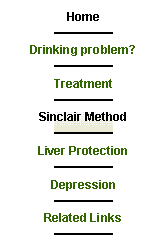


|
Effective treatment comes from understanding why the brain is craving.
Alcohol drinking is a learned behavior. Each time a person drinks, the alcohol causes some neurons to release endorphins (compounds similar to opiates) that reinforce the drinking behavior as well as the craving, feelings, and thoughts about alcohol. Year after year they become stronger until eventually alcohol can dominate one's life.
The Sinclair Method provides the first effective solution to the problem of excessive drinking. It utilizes a new form of medical technology developed by Dr. David Sinclair over the course of 20 years of research in the Biomedical Research Laboratories in Finland (Sinclair et al, 1973; Sinclair, 1974; 1987; 1990; 1997). Learning increases the chances of making a response or emotion that has been reinforced with food, water, or some other reinforces including alcohol. Extinction removes the behavior that no longer produces reinforcement. Alcohol drinking is a learned behavior, and in some cases becomes too well learned. Some people receive so much reinforcement so often (partly because of their genetic predisposition), that alcohol drinking, and thinking about alcohol, come to dominate their lives and cannot be controlled by normal means. Some are classified as alcoholics. However, many more people are not yet alcoholics, but nevertheless are drinking more than they should and more than they want to. So they will try to "cut down" or they promise themselves that they will "stop" drinking. But they fail, try again, and fail again. They soon >find themselves in a vicious cycle of trying the traditional methods that are promoted as the means to control their drinking. The traditional treatment of the last fifty years, or longer, that to control alcohol, one must first stop drinking. The Sinclair Method Program
The program focus is on thinking about the future and the various possibilities provided by a new life style. Client dignity is assured; there is not need for self-effacement since the motivation for alcohol is removed by extinction. Each client establishes his/her own goals for the program. The general goals are to decrease the dependency upon alcohol drinking and to develop the ability to control one's own consumption. Each client makes his or her own healthy decision to drink less, and stay within moderate limits or stop drinking completely. Using the Sinclair Method, you should not experience any health, personal, social, job, legal, or financial problems due to alcohol. If abstinence is the desired goal the Sinclair Method is the key to success.
More than 80%of all the clients in the Program were successful in long-term control of their alcohol consumption to abstinence or acceptable levels ("social"). For those who desired to control their alcohol intake, their drinking was reduced to an average of 1 per day. These were individuals who had previously reported their consumption to be 24 to 50 drinks or more per week. Some of SINCLAIR METHOD's successful patients have drank more than 200 ounces per week.
|
|
What is the Sinclair Method? |
|
SINCLAIR METHOD |
